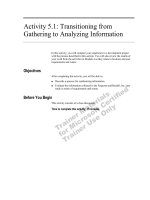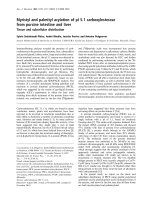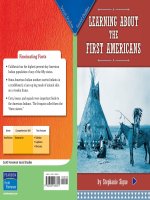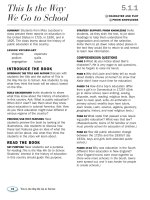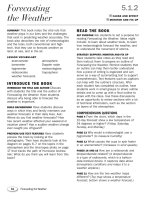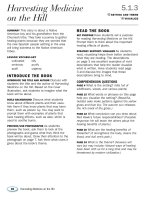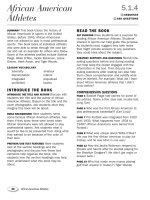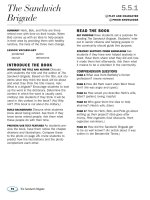5 1 1 learning from ms liang TG
Bạn đang xem bản rút gọn của tài liệu. Xem và tải ngay bản đầy đủ của tài liệu tại đây (119.86 KB, 4 trang )
Learning from
Ms. Liang
SUMMARY
A new teacher arrives and the fifthgrade class gets a lesson in what it feels like
to walk around in somebody else’s skin. Some
of the class bigshots learn what it’s like to be
treated like a nobody, and one student who
has been looked down on by the class gets a
chance to feel like somebody.
LESSON VOCABULARY
acquainted
essential
guaranteed
reputation
assignment
expanded
procedures
worshipped
INTRODUCE THE BOOK
INTRODUCE THE TITLE AND AUTHOR
Discuss with
students the title and the author of Learning
from Ms. Liang. Ask students to say what
they think the book will be about, based on
the title. Ask them to speculate about what
“learning” might mean.
BUILD BACKGROUND
Invite students to talk
about how they feel on a bad day. Ask them
if they have ever felt like a nobody and how
it felt. Invite them to talk about a time when
they understood how someone else was
feeling.
PREVIEW/USE TEXT FEATURES
Have students
preview the book by looking at the
illustrations. Ask students to discuss how
these text features give an idea of what this
book will be about. Ask what they think the
students in the story will learn.
5.1.1
CHARACTER AND PLOT
PRIOR KNOWLEDGE
READ THE BOOK
SET PURPOSE
Have students set a purpose for
reading Learning from Ms. Liang. Students’
interest in self-esteem and classroom relationships should guide this purpose.
STRATEGY SUPPORT: PRIOR KNOWLEDGE
Invite
students to use a graphic organizer to jot
down notes about places in the text that
make them think of their own lives. Suggest
they create a three-column chart with the
headings: Prior Knowledge, Characters, Plot.
Encourage them to include page references
with their notes.
COMPREHENSION QUESTIONS
PAGE 4
What was the first thing that the
new teacher did? (She wrote a poem on
the board.)
PAGE 7
According to Ms. Liang, what have
scientists discovered? (The expressions that
people make affect their feelings.)
PAGE 11
What flashback does the narrator
have in class when she’s trying to think of
something to write? (She remembers the
times A.J. said mean things to her and when
classmates laughed at her and made her feel
like a nobody.)
PAGE 13
Why did Ms. Liang tell students
not to sign their names on their first writing
assignment? (to protect students’ feelings;
some students might have been embarrassed
if she knew what they had written.)
PAGE 16
What was the topic for Ms. Liang’s
second writing assignment? (Write a paragraph about trying to get inside the skin of
someone you didn’t like.)
PAGE 18
What is the name of the poet who
wrote the poem that Ms. Liang put on the
board? (Emily Dickinson)
12
Learning from Ms. Liang
16917_LRD_TG_012-013 12
12/28/05 12:56:31 PM
REVISIT THE BOOK
READER RESPONSE
1. Answers will vary. Students might respond
that the narrator changed by learning to
understand how Lisa felt.
2. Possible responses: Did Know: She was a
poet. Now Know: Emily Dickinson wrote the
poem “Nobody” and never left home after
age 18. Students might want to know what
her parents and other people thought about
her.
3. acquaint, expand, guarantee, and worship;
Sentences will vary.
4. Answers will vary. Students might say that
they would have felt comfortable, knowing
that students like Lisa Linney also felt like
“nobodies.”
EXTEND UNDERSTANDING
Have students
comment on the illustrations in the selection.
Ask: Which ones do you like best? What
details about the characters are shown
in the illustrations? How would you have
portrayed the characters differently? Invite
students to look again at the photograph
of Emily Dickinson on page 24. Explain
that this picture was taken in the very early
days of photography. Ask students what
character traits they think are revealed in this
photograph. Have them point to details from
the photo to support their ideas.
RESPONSE OPTIONS
WRITING
Invite students to write a paragraph
about what people would understand about
them if people could walk around in their
skin. Tell them not to sign their names to
the paragraph. Have them write a second
paragraph about trying to get inside the skin
of someone they don’t like. Tell them not
to use anyone’s real name and to sign their
names to this paragraph.
SOCIAL STUDIES
CONNECTION
Students can learn
more about Emily
Dickinson by going to the library or
using the Internet. Challenge them to read
more of her poems and to find a favorite one.
Have them explain why they like this poem.
Skill Work
TEACH/REVIEW VOCABULARY
Invite students to use each of the vocabulary words in a sentence. Challenge them to
write sentences related to the selection.
TARGET SKILL AND STRATEGY
CHARACTER AND PLOT Remind students
that a character is a person who takes part
in the events of a story. Readers can often
determine character traits based on how
characters act toward each other. The plot
is an organized sequence of events. Authors
sometimes use flashbacks, in which the
action of the story is interrupted to talk
about something that happened in the past,
and foreshadowing, in which the writer hints
at events to come in the story. Challenge
students to note how characters treat one
another for clues to their character traits
and to find examples of flashbacks and
foreshadowing.
Help students brainstorm words that
describe characters, such as helpful, mean,
friendly, untrustworthy, lonely. Invite students
to write a description of a character from the
story using words from the list.
PRIOR KNOWLEDGE
Remind students that
prior knowledge is what a reader knows about
a given topic before reading about it. Invite
students to look for places in the text that
make them think of their own lives and to
use their prior knowledge to help them better
understand the characters and the plot.
ADDITIONAL SKILL INSTRUCTION
AUTHOR’S PURPOSE Remind students that
author’s purpose is the reason or reasons
an author has for writing. One reason for
identifying an author’s purpose is to adjust
the way you read. If an author’s purpose is
to explain something complicated, you may
want to read slowly or reread to make sure
you understand the information. Challenge
students to identify this author’s purpose
and to support their ideas with examples
from the book.
Learning from Ms. Liang
16917_LRD_TG_012-013 13
13
12/28/05 12:56:32 PM
Learning from Ms. Liang
Name
Character and Plot
• A character is a person who takes part in the events of a story.
• The plot is an organized sequence of events. Authors often use flashbacks to tell about
something that has already happened and foreshadowing to hint at events to come.
Directions Fill in the graphic organizer. Under Plot, include flashback and foreshadowing.
Title
Characters
Setting
Problem
© Pearson Education 5
Plot
Solution
14
16917_LRD_TG_014-015 1
12/28/05 12:57:21 PM
Learning from Ms. Liang
Name
Vocabulary
Directions Read each sentence. Write the word from the box that has the same meaning as the
underlined word or phrase. Some words may be used more than once.
Check the Words You Know
acquainted
essential
guaranteed
reputation
assignment
expanded
procedures
worshipped
1. It wasn’t long before Lisa adored Ms. Liang.
2. Ms. Liang told the class that it was extremely important for them to get inside
someone else’s skin.
3. She also established certain rules and regulations for participating in class.
4. Slowly, the class’s understanding of other people’s feelings grew.
5. By the end, even A.J. was ready to “get to know each other better.”
6. The narrator had trouble doing her writing homework.
7. Ms. Liang assured her students that she had once been a nobody herself.
8. Are you familiar with the poetry of Emily Dickinson?
9. By the end of the story, Lisa’s standing in the class had grown.
10. The narrator promised she would not make mean remarks about Lisa again.
© Pearson Education 5
Directions Write a summary of Learning from Ms. Liang, using as many vocabulary words as
possible.
15
16917_LRD_TG_014-015 2
12/28/05 12:57:22 PM
